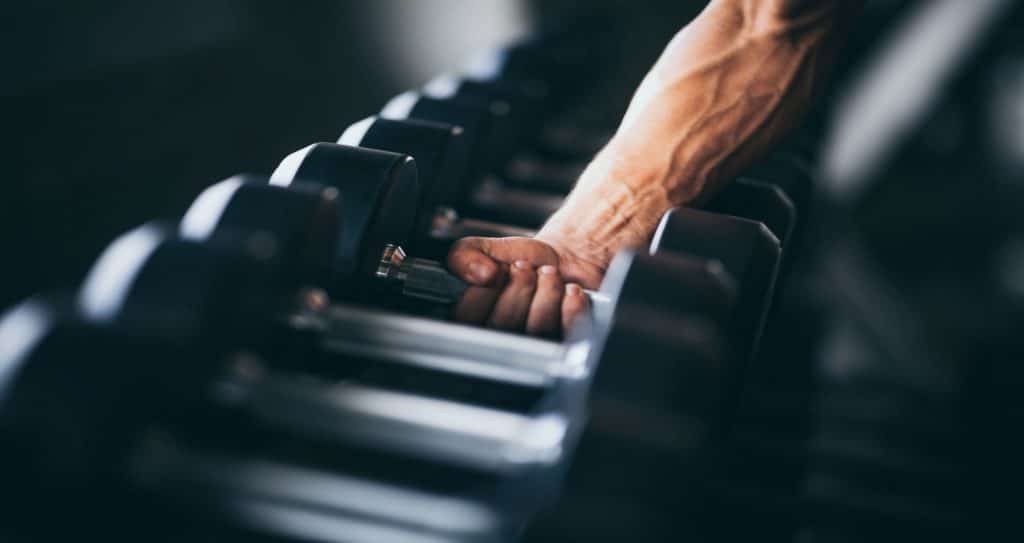The tripod dumbbell row engages your upper back and core muscles simultaneously.
The tripod dumbbell row is a modified version of the bent-over dumbbell row, known for its effectiveness in promoting muscle hypertrophy in the back (1). While traditional dumbbell rows primarily target the major back muscles, the one-arm variation also engages the core. Additionally, by adjusting your grip during this exercise, you can specifically target and emphasize different muscle groups.
The tripod dumbbell row is highly effective in engaging your core muscles. This unilateral pull exercise primarily targets your upper back muscles due to the dumbbell hold. Although challenging, tripod dumbbell rows offer more benefits than other row variations.
This comprehensive exercise guide will explore the correct tripod dumbbell row technique. Additionally, we’ll explore the many benefits of this routine and present alternative row variations you can experiment with. For a deeper understanding of these exercises and more, continue reading below.
Techniques & Muscles Worked
The tripod dumbbell row works on your lats, traps, rhomboids, abs, and biceps. It does this unilaterally, which builds strength in both arms by working them one at a time. Research shows that during unilateral exercises, you increase strength even in the arm you’re not using (2).
You need a dumbbell and a bench to do the tripod dumbbell row. Mobility in your hips is also essential when doing this exercise. Below is a step-by-step guide to doing the tripod dumbbell row.
- Assume a stance with your legs at shoulder-width distance apart and place your left hand on the bench.
- Hold the dumbbell in your right hand and then brace your core.
- Push your hips backward until your back is parallel to the floor, but keep your back neutral. This is your starting position.
- Holding your arm out, row the dumbbell with your right hand towards your hips until your elbow slightly passes your body.
- Squeeze your back muscles and slowly lower the dumbbell to return to the starting position to complete the rep.
- Switch hands and then repeat steps 1 to 5.
Benefits
This row is an advanced variation of the one-arm dumbbell row that activates your core more. Doing this exercise gives you two-in-one benefits of working on your back and your abs. Below are more reasons to add the tripod dumbbell row to your routine.
Grow Your Back Muscles
These rows happen in a bent-over position, which is excellent for your back muscles. The resistance from the dumbbell hits your lats, rhomboids, and traps. While the specific targeted muscle of this exercise is your upper back, it also recruits your lower back muscles.
Sculpt Your V-Taper
The V-taper is one of the best ways to show off your hard work in the gym. These rows build your upper body muscles while sculpting your obliques. This is one of the best ways to sculpt that V-taper look.
Find & Fix Muscle Imbalances
Muscle imbalances occur naturally, but with unilateral exercises, you can find and fix them. You must add a few extra reps to your weaker side to build strength. You can also slightly increase the load you use for tripod dumbbell row reps on that side.
Improve Your Posture
It strengthens your back and other muscles around your spine. Strengthening these muscles helps your posture and could reduce the pain of sitting at a desk all day.
Carryover to Squats & Deadlifts
The tripod dumbbell row targets your upper back muscles, providing a stable barbell base during squats and deadlifts. Besides, an engaged upper back stops your squat from turning into a good morning. It also lets you keep the barbell close during the deadlift, which improves your technique and helps you avoid blowing out your back.
Tripod Dumbbell Row Alternatives
The tripod dumbbell row is an excellent exercise for stability and building your back. It’s a unilateral row, and these rows are great for improving your core strength and fixing imbalances. Below are some other great unilateral row exercises you should consider adding to your routine.
Bird Dog Row
If you think the tripod dumbbell row is challenging, you haven’t tried the bird dog row yet. This brutal unilateral row is excellent for your lower back and core but requires great stability. To do it, you assume the bird dog position on your bench.
Meadows Row
The Meadows row will also train your back extensively and help to improve your posture. However, Meadow rows are also significant for your grip strength. You use an overhand grip and assume a staggered stance to do the Meadows row.
Dead Stop Row
The dead stop row is great for building strength and also targets imbalances. It takes the stretch pattern from your one-arm dumbbell row and trains it from a stop. This unilateral row variation is also very effective as it increases your range of motion.
FAQs
What muscle does the tripod dumbbell row work?
The tripod dumbbell row is a two-in-one exercise that builds your back and core muscles. It also recruits the muscles in your arms. Check the exercise guide below for a more specific muscle breakdown.
What is the difference between the dumbbell row and the tripod row?
The tripod row is a more advanced variation of the bent-over dumbbell row. The main difference between both exercises is that the tripod and dumbbell rows are in the technique and muscles worked. The tripod row recruits your core muscles more than the dumbbell row.
Follow us on Instagram, Facebook, and Twitter for more exercise guides!
References
- Mannarino, P., Matta, T., Lima, J., Simão, R., & Freitas de Salles, B. (2021). Single-Joint Exercise Results in Higher Hypertrophy of Elbow Flexors Than Multijoint Exercise. Journal of strength and conditioning research, 35(10), 2677–2681. https://doi.org/10.1519/JSC.0000000000003234
- Munn, J., Herbert, R. D., & Gandevia, S. C. (2004). Contralateral effects of unilateral resistance training: a meta-analysis. Journal of applied physiology (Bethesda, Md. : 1985), 96(5), 1861–1866. https://doi.org/10.1152/japplphysiol.00541.2003








